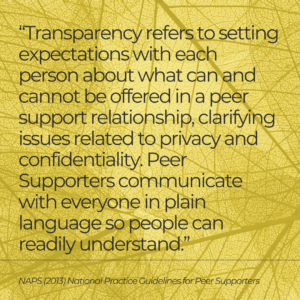Peer Support is an extremely effective and evidence-based mental health service that uses a person’s lived experience to help others in their recovery. This blog is part of a series that will take a deeper look at what it means to work as a Peer Support Professional and how to adhere to the ethical guidelines created by the National Association of Peer Supporters (NAPS).
For this blog, we will be focusing on the guideline that states peer support is transparent.
 Why is this guideline important?
Why is this guideline important?
We have all been there at one time or another – whether it’s when we are filing taxes, signing a lease, or even visiting the doctor. While trying to gain access to necessities like housing or health care, we are often met with complicated legal language or policy conversations. Despite whatever purpose the language may serve, it can make things seem more confusing or even intimidating rather than supportive when it comes to having our needs met. While more organizations are finding ways of working transparently with the communities they serve, there is still a lot that needs to be done in order to support individuals in making informed decisions based on clear communication.
Peer Support Professionals can be a wonderful source of supportive transparency. First off, having lived experience of what it’s like to navigate through certain systems or resources can help Peer Support Professionals “pull back the curtain” for other’s who may be seeking similar resources. But perhaps most importantly, Peer Support Professionals should always strive to be a source of transparency through their own work by using clear and understandable language, being open about what they can do in their role, and using what NAPS calls a “humanistic manner.”
A humanistic approach is the belief that each person is uniquely valuable and that they will be best supported through genuine person-to-person relationships. Genuine relationships cannot be established through complicated language or confusing policies. By engaging in the value of being transparent with others, Peer Support Professionals can achieve this kind of connection in order to support others in their recovery. And there are so many different ways this can be done.
What does this guideline look like in practice?
When working with someone new, one of the first things you should try to do as a Peer Support Professional is explain a little bit about your role and the kind of support you can provide. There will always be opportunities later on to expand on what a Peer Support Professional can do, so there isn’t a need to dive too deeply in your first meeting. Especially if the person you are working with needs immediate support or has a limited amount of time. However, there are certainly a number of things that can be helpful for a person to know at the start of the supportive relationship:
- Let them know that as a Peer Support Professional, you are a person with lived experience.
- Clarify that your role as a Peer Support Professional is different from a provider role like a case manager or a therapist and spell out some of those differences.
- List any policies and procedures that you as a Peer Support Professional must adhere to like privacy and confidentiality, especially if they provide information to you that must be shared with others.
- Inform them of any other specific organizational rules or procedures that you have to follow as an employee (i.e. time limits or mandated reporting) that will impact your relationship.
Giving a brief explanation of what a Peer Support Professional can do and the rules you have to follow at the start of your work together allows a person to make informed decisions about how they’d like to move forward. Additionally, if clear expectations are set and understood by all, you will both feel a lot more comfortable as you communicate and build your supportive partnership.
As your journey together continues or as you work with other people, remember to continually strive for that same level of mutual understanding and transparency. For example, always try to use clear plain language, rather than clinical language or other kinds of medical jargon. This can not only help further the distinction between providers and Peer Support Professionals, but it can also make sure you are both on the same page when discussing things like wellness tools or recovery program options.
How to use this guideline moving forward
While recovery can be an incredibly empowering experience, it is not without its challenges that may leave someone feeling lost. It can also be especially easy to feel disoriented by systems that are designed to support us on that journey but might be confusing to engage with. By following this guideline of transparency, Peer Support Professionals can provide a kind of clarity and humanness that not only promotes a stronger human connection, but also allows others the opportunity to take charge of their recovery journey.
